main: October 2004 Archives
Lessons in Art History
You knew it was coming: more about Isamu Noguchi (1904-1988). My June 21 entry (you can find it under Archives, June in the column to the left) covered the reopening of the Noguchi Museum in Queens and included a lot of his biography that I really don't need to repeat.
Although the Noguchi Museum has its charms, I wanted to see a more traditionally curatorial view of his sculpture in a white-walled venue, removed from the artist's personal aura.
This indeed is what we have at the Whitney (945 Madison Ave. to Jan. 16). For another view of this view, the exhibition will be in D.C. at the Hirshhorn Museum of Art, Washington, D.C. from Feb. 10 to May 8. "Isamu Noguchi: Master Sculptor" is a collaboration between the two institutions. Given the high cost of mounting serious surveys, collaborations between (or even among?) like-minded institutions is an economic option rapidly becoming an economic necessity. Museums have even taken to joint ownership of artworks.
Viewing Noguchi's The Sun at Noon (1969) at the Hirshhorn after seeing it at the Noguchi Museum, and then at the Whitney, might be one viewing too many -- or just enough. Will it be like seeing a donut inside a donut? The sculpture is an up-ended ring or marble Hula-Hoop; and the Hirshhorn, for better or worse, has been called a donut of a building. The Sun is probably the best of Noguchi's sculptures after his high point: the biomorphic, interlocking sculptures and the "Lunars" of the '40s. The carved works really disappoint. For all their so-called Zen austerity, they are inordinately fussy, implying that not every art career is a ladder ending in triumph. Some can be an arc.
That said, this is nevertheless an exhibition long overdue. How would we know that the carved works are wanting if we don't see them? How else are we able to evaluate the art of the past (and thus the present) unless we see the material in some depth? Single objects or photographs are not enough.
So the Whitney and the Hirshhorn are to be congratulated for living up to this aspect of their responsibilities. It doesn't really matter that the show is not in any major way critical. When one has to deal with estates and collectors in order to amass the required materials, the situation precludes direct criticality. That is left to us. One hopes for -- and in this case, more or less gets -- a fair array of examples of an artist's work, except for most of the design efforts.
The installation at the Whitney is fine: well-paced and airy. You can walk around the free-standing sculptures without any trouble, and they don't get in the way of each other.
At the Whitney, undistracted by the cinder blocks of the Noguchi Museum, it is particularly clear that, although The Sun is the most minimal of Noguchi's sculpture, the alternating sections of French red and Spanish Alicante marble preclude any real minimalist presence. These precise segments are the old-fashioned signs that what we are looking at is handmade art of some sort. Art changes as it moves from place to place. The artwork becomes the sum of its placements, and even of its photographs.
But I am getting ahead of myself.
* * *
If we start at the front end of the exhibition, we get a clear story. Paris: Noguchi put in some six months as Constantin Brancusi's studio assistant; the visible results areBrancusi-esque sculptures, the handsome gouaches I have not seen before, and, I suspect, the privileging of direct carving, taken up later in Noguchi's life. Japan: In the process of failing to make any satisfactory contact with his Japanese professor-father who had abandoned him and his American mother, Noguchi (who previously used his mother's name and called himself Sam Gilmour) discovered ceramics, with, I think, mixed results. New York: Interlocking Sculptures, Lumars, Akari Lamp Sculptures. And then the carved things, at first overlapping the Interlocking sculptures, and then supplanting them by the '60s.
But the most interesting part of the exhibition ultimately may be what for the sake of exhibition clarity has been omitted. We have to search through the catalog for the Earthwork precedents: Drawing for Monument to the Plough (1933) and Model for Sculpture to BeSeen From Mars (1947).
And, of course, Noguchi's gardens, playgrounds, and public art, because of their site-specific nature and/or demise, must remain out of sight. A few photographs might have helped, but apparently these works do not fit into a sculpture focus. But even the catalog is of no help, at least in terms of Noguchi's considerable design output. The Akari paper-lampshade light sculptures (a.k.a. lamps), admittedly masterpieces, are all we get in both the exhibition and the catalog. Where is the iconic coffee table? Where is the sofa?
In this regard, the Noguchi Museum inaugural exhibition, although nearly buried under Robert Wilson's theatrical darkness and pin-spot lighting, attempted a more balanced and complicated view.
According to curator Valerie Fletcher's catalogue essay for the Whitney/Hirshhorn exhibition, Noguchi himself favored his "sculpture" over his other efforts, but this was later in his career (in 1973 according to a footnote), when -- my addition -- he had stopped designing tables, sofas, and lamps.
Perhaps the problem is that of definition. "Sculpture" is here defined as portable, nonutilitarian stuff, as was usually the case in Noguchi's '40s and '50s heyday. Currently sculpture includes a lot more: Earthworks, artist furniture, installations, and in some cases even performance art. The language we grow up with is often the language that traps us.
Are we always to take the artist's word? No. Noguchi may have thought of his famous, biomorphic coffee table as just a money-maker, but it is one of his best artworks. We can think of it as a multiple, as usable art, as design art, or even as sculpture, but under any name it is art.
Does the artist always know the best way to display the art? No. The Sun, for instance, looks better against the white walls of the Whitney then at "his" Noguchi Museum.
* * *
The exhibition presents a number of surprises, not the least of which is Miss Exploding Universe of 1932, a floating, stylized, aluminum angel, named by Noguchi buddy Buckminster Fuller. Noguchi, the inveterate Bohemian, knew everybody.
Another delightful surprise are the materials used in Remembrance of 1944: string, bone, wood, but all deployed around an ordinary cardboard tube painted black on the outside.
On the negative side, it is a shock to discover how truly ugly the 1934 Death (Lynched Figure) really is. It is not the subject that makes it horrible, but Noguchi's inability to translate the subject matter into something horrible and perhaps even action-provoking. It is not good agitprop; it is not good sculpture.
This disappointment is balanced by the small room of light sculptures called Lunars (1944-45). They are of the same biomorphic ilk as the Interlockings, but hold the walls and ceiling with light. In short, they are wall and ceiling lamps.
The Interlockings, however, are Noguchi's masterpieces. I know they are anthropomorphic and thus not totally, religiously abstract. I know they have become textbook '40s. But is this why Noguchi didn't continue with them?
The puzzle, brought up in Fletcher's catalogue essay but not really solved, is why Wifredo Lam and Yves Tanguey in their paintings, and Julio González and Noguchi, came up with such similar forms. Did they see one another's work? Noguchi could not have seen González's biomorphic sculptures because he was working under the strictures of the Nazi occupation of Paris. But did he see Tanguey's paintings? Did he even know Tanguey, who was in New York? Does all this come from Picasso's paintings of beach damsels or the "Anatomy" drawings of the '30s? Or Miró and even Dalí?
Even if they might have seen each other's work, why was the notion of interlocking, biomorphic sections so fervently adopted? It was indeed a way of blending abstraction and figurative surrealism. But to go a little deeper, could it be that the forms resonated with wartime horror and depersonalization? The body falls apart into blobs of meat. The results are rather like the old trick-drawing: are we looking at a beauty queen or a witch? Both. Perversely, the forbidden and hidden text is that in disintegration there can also be liberation, which is why some of these works -- particularly Noguchi's -- are oddly joyful.
The Interlockings grew out of dealer Julien Levy's assignment to various artists to create chess sets. This is the first time Noguchi used construction-paper cutouts that could be interlocked to create free-standing, three-dimensional sculptures. He then made larger forms out of plywood as a stage set for his friend Martha Graham's 1944 Herodiate.
Slate, since it was cheap, easily cut and polished with a portable tool and, having no possible wartime use, was readily available. Noguchi began to make the Interlockings as nonutilitarian sculptures, working in the courtyard of his MacDougal Alley studio in Greenwich Village. The black construction-paper segments -- looking like bones, arms, penises, strange alphabets -- were pasted to graph paper, enlarged into patterns, and then cut from slate and other materials. I have never seen these worksheets before. Although they are handsome in themselves and another surprise addition to Noguchiana, they may further clarify the Interlockings process or game.
But even without the worksheets, after a few minutes of puzzlement you can figure out how and why the Interlockings stand up. You can see how the configurations are held together by notching and gravity. One piece of material penetrates another or is hung from another. In your mind you have participated in their making. That they are approximately your own height is a bonus. Mostly placed together in one room on a large central platform, they create a dance of themes-and-variations.
Is it such a closely guarded secret that what many of us like about sculpture and even painting is that, given the right natural signs, we can in our imaginations participate in their making?
This of course also happens, but in a minor way, with the latter-day carvings on which Noguchi lavished so much attention. But, alas, bored holes and/or little notches here and there, all (surprise!) revealing the slate beneath the crust, is just not enough -- or, in the light of contemporary and competitive minimalism, is too much -- to keep our interest.
Why did Noguchi's creativity ebb after the Interlockings? Did his success undermine his talent for using unusual materials ? Did he need to rub up against poverty, utility and theater to be at his most creative?
Until we have a full survey of his gardens and other public works (impossibly difficult to pull off), we may never really know if he really did he lose his spark. The sunken Chase Manhattan rock garden/fountain in downtown New York still looks great. Perhaps the late "sculptures" should be seen as garden sculptures or space markers -- as may be evident in the Noguchi Garden in Queens -- rather than as standalone artworks.
After the Interlockings, Noguchi's sculptures per se are simply not severe or complicated enough, or sufficiently challenging. He cannot compete with David Smith or later with Anthony Caro or Tony Smith or Donald Judd. In fact, Noguchi's late sculptures (combined with the lingering stranglehold of Barbara Hepworth and Henry Moore) are why we had no choice but to turn to minimalism in the '60s.
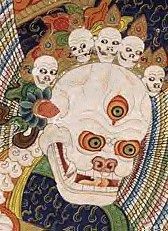
Tibet Invades Chelsea's Eastern Border
So far, the most significant art event this fall is the opening of the Rubin Museum of Art (150 W. 17th St.)in the huge building that once housed Barneys. Ages ago, Barneys featured boy's and men's clothes off-the-rack then went upscale and then uptown, leaving a vacant building behind on Seventh Avenue between 17th and 18th. Of course, MoMA is set to reopen this November in expanded quarters. And it will be great to see some of our favorite paintings and sculptures again in, we hope, a new and appropriate environment.
Unfortunately, some of us fear that the new $20 admission fee will be a barrier to the young, the poor, and the retired. For those who go often and can afford to become a member, the museum will still be a bargain. But that doesn't seem quite fair, since MoMA benefits from its nontaxable, nonprofit status; the money the government does not get from MoMA has to come from somewhere. (Guess where: ultimately from me and you.) And yet...MoMA, like other museums, needs ever more income. My solution is that entrance fee should be based on income. The rich should pay more, not less. And students, the poor, and the retired, since they have little or no spare cash, should walk in free.
The Rubin Museum -- devoted to the Hindu, Bon, and Buddhist art of the Himalayan region --is modest in size and in admission price (adults $7, seniors, students, neighbors and artists $5), but even MoMA will not have a staircase by Andree Putnam. And like the beautifully underplayed staircase held over from Barneys, everything about the Rubin Museum has been well-thought out and well-executed. Milton Glaser did the identity and the graphics. The educational components are perfect: just enough wall texts, skillfully written (which, as you know, is a rarity). And if you want, there's free audio guides and alcoves with computer screens offering even more information. Given the complexity and the strangeness of the art, you could spend as much time at the Rubin as you would at MoMA, maybe even more.
Each of the six (!) floors -- the Putnam staircase is at the core -- allows a clear path or arc through the easily read thematic presentations. Helpful docents greet you, actually greet you, at each landing. Magnifying glasses are offered for viewing details of the complicated tankas or scroll paintings.
None of this is intimidating. It is, after all, not the entire Barneys that has been appropriated, but just enough to afford the right space for looking at some very esoteric art, requiring contemplation and perhaps more than a littlestudy.
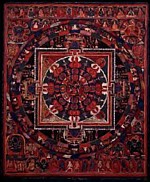
Mandala of Chakrasamvara, 1300-1399 (Himalayan Art Website)
There is a mass of unreliable testimony that Perrault did and could do all kinds of impossible things. It was supposed, for instance, that he practiced the art of self-levitation, of which so much appears in accounts of Buddhist mysticism...
-- James Hilton, Lost Horizon
I count the Buddhist (and pre-Buddhist Bon) art of Tibet as one of the wonders of the world. I suppose, though, that since political borders have been fluid in that vast mountain region, one should more properly speak of the art of the Himalayas and immediate regions.
Like many, I will probably never visit Tibet. I make plans -- which are more like guide-book fantasies -- and something always comes up. I thought it best to go to Lhassa via Katmandu, where there are friends-of-friends and I might get a chance to acclimate before continuing on to the top of the world. Traveling by way of China seems a betrayal of one's support of Tibetan independence. But now there seems to be a Maoist insurrection in the countryside of Nepal, making even Katmandu, the capital city, potentially dangerous.
Could I deal with the altitude? Last time in Aspen I got the bends, and that's only 10,000 feet. Well, I suppose so, since I've read there are special oxygen pillows in the Chinese-run tourist hotel. But more important, how much is left of the real Tibet to see, or that one is allowed to see? Shouldn't I see it before nothing Tibetan is left in Tibet?
I suspect, in any case, that the real Tibet is a Tibet of the mind (like the invisible kingdom of Shambala, north of Tibet) and I've already been there, lived there, left it behind.
How else can I explain my deep response to Tibetan art? I am in fact not even a Buddhist, although in my youth I briefly thought I was. I have nothing against compassion, but vegetarianism, which I assumed was required, made me ill (it appears I have carnivore Viking genes). Furthermore, hierarchies, no matter howbenign, are anathema to me, with the possible exception of heavenly hierarchies, if there are such. Rules supposedly for your own good are still rules. What else could my vivid dream of tunneling out of a Zen monastery have meant?
Nevertheless, Tibetan Buddhism is the unofficial art-world religion; look at the sponsor list of any Tibet House event. I myself was once on the board of the Jacques Marchais Museum of Tibetan Art on one of the densely populated peaks of Staten Island, Todt Hill -- the highest point on the East Coast south of Maine. ("Todt" in Dutch, as in German, means death.)
There was no Jacques Marchais; that was the pseudonym of a New York dealer in Asian art who became so fascinated with Tibet that she built a reproduction of a Tibetan monk's retreat facing the Verrazano Straights far below and then stocked it with tankas (paintings that can be rolled up) and small bronze sculptures. It turns out that, like myself, she had never been to Tibet, where there are the highest points or peaks in the world.
Just up the hill from Frank Lloyd Wright's Usonian house (his only house in New York City), the Jacques Marchais has always tried for local outreach. Surely everyone on Todt Hill needs to know about Tibetan art. One docent -- a kindly gardener-type who is a Miss Marple lookalike -- told me of her first experience at an open house Saturday. A local stormed out of the picturesque stone building and out through the charming garden, dragging his kids. Having seen the many-armed statuettes inside, he was convinced that it was all "the devil's work" and was going to report this devil-worship on Todt Hill to his parish priest. He simply did not understand that the fierce beings sometimes depicted in paintings and in metal statuettes are not devils, per se, but meant to protect you from devils, desires, and bad thoughts. Think gargoyles, not Black Sabbath.
You may not have done much reading in Tibetan Buddhism. You may not know who Milarepa is and that Naropa is more than poetry workshops in Boulder, Colorado. You may still get Red Hats, Yellow Hats, and Black Hats all mixed up, and not know a prayer wheel when you see one. Yet most likely you will get something out of Tibetan art. Contemporary art has already prepared you for it: your experience with repetition, flat fields of color or figuration, non-European composition (or anticomposition) will open the first of many doors.
You may not know about or believe in tertons or psychic lamas who can discover hidden treasures of esoteric teachings -- sequestered in caves, inside trees or rocks, and unavailable until we are able to use them. But here's a thought: perhaps the dispersal of Tibetan art and culture (on the face of it, yet another awful Diaspora) is like the terton-discovered texts of the past. We are ready to receive the teachings we now require.

Mandala of Vajrayogin-Vajravarahi, Red, 1400-1499 (Himalayan Art Website)
It seems impossible...And yet I can't help thinking of it -- it's astonishing -- and extraordinary -- and quite incredible -- and yet not absolutely beyond my powers of believe.
What is, my son?
And Conway answered, shaken with an emotion, for which he knew no reason and which he did not seek to conceal: That you are still alive, Father Perrault.
--- James Hilton, Lost Horizon
Of further assistance (I hope):
Yes, the iconography of the tanka scroll paintings is obscure to most of us. These images (think Greek icons) are meant to be mysterious, complicated, mind-stopping, but like their closest Western equivalent in the Eastern Orthodox Churches, they are meant to have a direct mystical effect; they are alive. They are wisdom vehicles, transcendence machines. Tibetan art is instrumental.
Even though many are single instances from broken sets? Certainly. Although you might think this is like trying to figure out the plot of the Stations of the Cross with only one station in front of you, each tanka has the same energy as the bigger picture. All cells from the same body have the same DNA, carry the same message.
Even those that are narratives of the lives of the Buddha(s) or saints? As in any art, how you tell the story is often more important than the plot. Besides, not all tankas are parts of narrative sets; sometimes the sets were collections of revered lamas, teachers, or saints. A Western equivalent might be separate paintings of each of the Apostles.
Oddly enough -- or perhaps not so oddly if you respond most efficiently to abstract art -- the mandalas may work best for you. You have read Kandinsky's On the Spiritual in Art. You have read Jung, so even your brain is well-trained to expect something to happen when you look at a square within a circle within a square within a circle, etc. Suddenly you are "reading" pathways the way you might read the diagrammatic, alchemical mandalas of Europe. You are entering some beautiful palace, not unlike the palace in Second Temple Jewish mysticism.
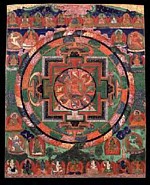
Mandala of Yamari, Rahta, 1600 - 1600 (Himalayan Art Website)
At the inaugural exhibits at the Rubin Museum, each floor explores a particular theme. It is recommended that you start at the second floor and work your way up. Of course, being a well-known contrarian, I started at the top and worked my way down (as one should at the Guggenheim). Does this account for my backwards view of history? In this view, all artists decline as they get closer and closer to their beginnings. Amazingly, I still locate the golden age in the future.
Since the concise exhibitions here are laid out in the form of an ascent to higher realms, I would do the handout one better and start at the Theater Level, with Kenro Izu's beautiful photographs: Sacred Passage to Himalaya, grounding oneself in photo-reality, as it were, before going on to Sacred History: Portraits and Stories on the second floor. The third floor offers Perfected Beings, Pure Realms. Demonic Divine on the fourth landing brings in a few borrowed Day of the Dead Mexican works to show other examples of scary art, but none are as "scary" as a Tibetan ritualistic bowl made out of a human skull or the gold-on-black tankas that will certainly ward off any art-world evil eye of envy or personal greed demon. More soothing are the Portraits of Transmission the next flight up. Finally, the sixth floor shows Methods of Transcendence, which includes a few spectacular mandalas.
Along with the link I have already provided above for the Rubin Museum, here are some additional ones for further illumination and information:
Tibet House at 22 W. 15th Street is now featuring the Repatriation Collection, a gift from the Rose Museum of Brandeis of what was formerly the Riverside Museum Collection of Tibetan Art.
The Jacques Marchais Museum of Tibetan Art has a website that features panoramas of the museum building and photos of a blessing ceremony by Tibetan monks, taking place on the museum terrace.
The Tibetan Buddhist Resource Center provides information online about persons and placesin Tibetan history, and more.
The Himalayan Art Website, sponsored by the Shelly and Donald Rubin Foundation, offers concise explanations 17,000 images of Tibetan art.
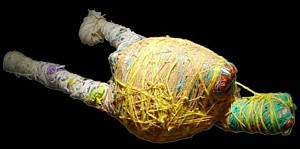
Judith Scott, Untitled, n.d.
WHAT'S IN A NAME?
[Presented Oct. 8 in Oakland, Ca.at "Margins and Mainstreams: Disability Art Today," American Folk Art Society Conference, hosted by The Creative Growth Art Center.]
Disability Art, as in the title of this symposium, is a new term for me. I think I know what it means: art by those with disabilities, art by the physically, mentally, and emotionally disabled.
But do we need yet another art term? Elsewhere in my work as an art critic, artist and poet I have been busily de-defining or un-defining both art and artist, by my practice or sometimes by examining the definitions that exist or are continually being proposed.
Since the excellent work done by the Creative Growth Art Center involves not only teaching art to the disabled but also marketing that art, on one level the term Disability Art makes sense. I first became aware of the Creative Growth Art Center because of the bound and wrapped sculptures of Judith Scott: mission accomplished. Scott has Down's Syndrome and had to be rescued from a state institution by her once long-lost twin sister. Whether we call Scott an Outsider Artist or a Disability Artist, her sculptures are superior to most art-school art now clogging up the art system.
Yet I always worry about terminology. As I have often said, taxonomy is destiny, so I'd like to question if we really need another term. Won't Folk Art or Outsider Art do? But please beware. Once we examine the words we are using, we are unable to ignore that meanings -- and categories --are unstable.
Let's begin with Folk Art, which I define, rather academically,as art made for local communities by academically untrained artists in those communities. I specify "local communities" because we now have nonlocal communities such as those formed through the internet. And, of course, there are nonlocal communities of doctors, lawyers, poets, artists, art collectors, gay men and lesbians, and persons with various political views, specific tastes in music, and even specialized art collectors held together by print publications, conferences, resorts, and rumor.
Tourist Art is iffy, because it is not made for the locals. But we'll pass on that.
I also say "academically untrained artists" becausefolk artists are not really self-taught, but learn their skills through an apprentice system rather than through formal attendance at an art school or academy.
Now to make matters more complicated, the definition of Folk Art appears to havebeen expanded by The American Museum of Folk Art in New York to include art that has been variously labeled as Art Brut, Outsider Art, Grassroots Art, and even Visionary Art. Art in these categories is more often than not situated against local communities and is generally thought to be made by lone-wolf rather than community artists. I assume this means the American Folk Art Museum is now embracing all art by persons without academic training.But one never knows, since currently their exhibition is of jewelry (and hardly even art jewelry), of a kind made by those who have gone to one design school or another.
* * *
An aside:
We know that various state and national officials are now examining nonprofits for conflicts of interest and other sins. Might they also look at whether or not a museum follows its mission statement? Not only is the Folk Art museum showing commercial jewelry, the Guggenheim is showing Aztec art. Will MoMA get away with showing the art of ancient China? Will the Cooper-Hewitt show photography?
The former American Craft Museum may be ahead of the curve: it changed its name to the Museum of the Arts and Design and thus, with the exception of items of natural history,it can without guilt show practically anything, even craft.
Other museums might get into trouble.
If I were a donor to or a dues paying member of the Museum of Birds Nests and suddenly my institutionhad an exhibition of automobile tires, I would feel more than cheated: I'd feel swindled and not want totoss them money ever again. As a former museum person and nonprofit executive, I know how difficult it is to raise money and can easily understand the temptation to yield to the nearest salesman carrying a briefcase full of bucks. But don't average donors deserve some protection? Isn't a Birds Nests museum that shows automobile tires guilty of false advertising?
A Continuum of Disabilities
I assume the proposed category Disability Art also requires the "academically untrained"proviso, here meaning art made by persons who have not been to art school (but allowing those who have been helped by the Creative Growth Art Center).
I think it would be best to exclude the work of art-school artists, for in fact there is a rather large number ofacademically trained artists -- what I call art-school artists -- who also have disabilities of one sort or another, usually not severe enough to require institutionalization or needing specialized therapy (or at least not yet), but which could be seen as handicaps.
I do not mean to denigrate or make light of really serious disabilities, but to indicate that disabilities exist on a continuum. Also I sometimes like to make fun of art-school artists.
I was once startled and enlightened at a craft conference attended by perhaps 400 or so crafts artists. The former head of a now-discontinued craft section of the National Endowment for the Arts asked the assembled crafters to raise their hands if they suffered from dyslexia or other learning disabilities. I would estimate that at least 80 percent of those present owned up.
The speaker went on to say that this once again confirmed her thesis, developed when she was at the NEA, that crafts artists almost universally suffer from dyslexia and other learning disabilities. She added, if I remember correctly, that perhaps crafts work was a way of compensating for other modes of expression and understanding, and that perhaps -- there was a gasp -- that the crafts could play a key part in art therapy once again.
The shock here was not about disability-consciousness, but at the term art therapy, because, you see, even craft, if it is to be art, is not supposed to provide social benefit. I myself don't shrink from the term art therapy, since I do not believe that art must be pure and above use, or even that it can be.
I wonder what the results would be if all artists were polled.Perhaps not 80 percentbut maybe 79 percent would wave their hands if they were being honest. I base my guess on many years of teaching art students who, if not exactly artists, are would-be artists. But also upon the lack of reading skills displayed through the manner in which painters and sculptors react to art criticism, even when it is about their own work. And even when it is favorable. You usually have to spell out: yes, this means I like you, I love you.
I can't really count how many studio visits I have made in my 40-year career as an art critic, but I can assure you I am always shocked at the paucity of visible reading material. Many artists have no books at all, even in their living quarters. The only books they may have are books about themselves.
There are other kinds of disabilities I find endemic among art-school artists: egomania, pathological competitiveness, and greed. But we had better not go along that path, because I am in the minority as seeing these character traits as disabilities: they may indeed prepare artists for the road to success in the art world. They are, however, disabilities if one sees soul-growth as a goal just a bit higher than acquiring a blue-chip gallery, a BMW, a summer house in the Hamptons, an Abrams picture book, and a museum retrospective.
I will always stick to the view that artists make art in spite of their disabilities rather than because of them. This goes for the egomaniacal, super-competitive, greedy artists we all know about as well as for those who have medically diagnosed physical or mental impairments of one kind or another. Their art is their health. It is, I would propose, people who do not make art, compose and/or interpret music, or write and/or readpoetry who are disabled. The poet Ted Berrigan spoke of those who don't write poems as being partially crippled, which certainly does turn things around.
Institutionalization
Another point:
Can we limit our definitions of Outsider Art or Disability Art by including only those artmakers who are under some form of institutional care?
If so, what do we do about someone like the Japanese artist Kusama, whom no one considers an Outsider Artist or Disability Artist? She is most famous for her naked street performances, her use of polka-dots, her mirrored rooms, and for encrusting various objects with small-scale stuffed penises. For many years she has lived in a mental institution in Japan. Of course, she committed herself and seems to be able to come and go at will. Since her family is enormously wealthy, she can pay her own keep.
What I am suggesting is that the main difference between Kusama and, let's say, Martin Ramirez (whose intense drawings and collages are generally classified as Art Brut, Outsider or Visionary)is not art-world exposure, but personal wealth. It is odd indeed that most Outsider Artists are poor, when we know that the rich can be just as crazy as the poor, and perhaps even more so. The rich have the money to protect themselves from the state and/or medical interference.
In the '70s, I would show my students slides of unidentified art works and defy them to decide which paintings and sculptures were by women artists. I think that now one could also show an array of unidentified artworks that would be impossible to separate into Outsider versus Insider art.
Obsessiveness? Many mainstream artists display obsessiveness in their art. (I would include Sol LeWitt, Chuck Close.) Centralized or nonhierarchical imagery? Confusion of animal/human categories? Use of nonart materials? Mythomania? All of these characteristics can be found in art-school art.
On the other side of the coin, as it were, Outsider Artists (and I will use this category to include Disability Artists as they are now being marketed) are expected to provide the unexpected, to be original and not to care about any possible audience. Thus they are not very different from artists of avant-garde Insider Art. In fact, a case can be made that Outsider Art is now a part of Insider Art. Art-school art has opened up to include antiformal strategies, obsessiveness, and even myth, so strictly on the basis of what we are looking at we cannot tell Outsider Art from Insider Art. We need the added knowledge of a lack of Insider training and of psychological if not social and cultural isolation.
On the other hand, one could say that Insider Art, unlike Outsider Art, is always inspired by existing models, no matter how far-flung, and is usually art-about-art. The difficulty is that now those models can be Outsider Art or Art Brut, as Jean Dubuffet called the art he so cleverly imitated.
The Sincerity Problem
But in a final paradox, I don't want you to worry too much about imitations, appropriations, or even outright fakes -- and there are such. Anytime there is money to be made or a leg to be pulled, fakes will appear. I have heard of at least one art-school artist (he is actually a professor of art) who has a nice little Outsider Art career under another name. But my paradox is this: sometimes the intention of the artist or even his or her sincerity is of no importance.
As a very young man, I was very excited to make my first studio visit. The artist was a boyfriend of a friend, and he made a lot of money painting Madonnas for the Washington Square Outdoor Art Show -- where Franz Kline got his start, but which went immediately downhill to become the biggest shlock fest in America. My friend's boyfriend had a bigger studio behind his Madonna studio: this is my real art, he said, I am really an abstract painter. The joke on him was that his Madonnas were actually better than his bad but seriously executed abstract expressionism.
Then too I am reminded of Ern Malley, my favorite Australian poet from the '30s. He didn't actually exist, but was a hoax created by two really bad conservative poets, James McAuley and Harold Stewart. Which would you prefer: "The Revolution, now betrayed?/By whom misled, by what dismayed?" by McAuley or "When the hysterical vision strikes/The façade of an era, it manifests/ Its insidious relations" by "Ern Malley"?
Which would you prefer: "Now in the brazen zenith hung, the sun/ Clashes the cymbals of the solar disc..." by Stewart or this gem by Malley: "I have been bitter with you, my brother,/Remembering that saying of Lenin when the shadow/ was already on his face: 'The emotions are not skilled workers' "?

Guy Maddin, The Saddest Music in the World, 2003 (Isabella Rossellini as Canadian beer tycoon)
ArtOutside the Art Galleries
At a time when it is hard to avoid movies or digital projections in art galleries, why not go back to origins? Musician/artist Brian Eno once prophesized that although it might seem that art has disappeared, we would find it again in an unlikely place. Could that be in movie theaters and thenon DVDs?
Not only is the maddeningly eccentric Guy Maddin incredibly visual, he is a movie auteur. I like putting the two terms together, for as an author (an artist), Maddin -- like John Waters, the Baltimore filmmaker who has given us Pink Flamingos and Hairspray -- is making movies rather than film or cinema. Even his most outrageous images are employed in the service of storytelling. In Maddin's case, however, you don't know if Isabella Rossellini's beer-filled glass legs (in the 2003 "big" budget The Saddest Music in the World) are an homage to surrealism, or making fun of it. I vote for making fun. But am I right?
If making fun is Maddin's main talent, why are we so often disturbed and/or moved by his fey, outré, over-the-top absurdities? The real-life Maddin has a weird neurological disorder that causes him to feel he is being poked by ghosts. There are ghosts in his movies, too. His older brother, who at age 16 committed suicide on the grave of his freshly buried sweetheart, is always in the background. But there are other ghosts too, and I do not mean only ghosts-of-movies-past.
As a way of dealing with tragedy, Maddin's movies are firmly planted in camp or, more properly, meta-camp; in his own archeology of silent film; in his childhood; or in the mores and local legends of Winnipeg, Canada, his flat and icy hometown. If you thought Baltimore was an unlikely place for filmmaking, just think of Winnipeg. I think I lectured there once, but the only thing I really remember is parking meters with electric outlets: you plug in your motor blanket to prevent your engine block from cracking in the cold. In Waiting for Twilight -- a documentary extra that comes with Twilight of the Ice Nymphs (1997), Archangel (1990) and Heart of the World (2000), all on a recent DVD -- a Maddin crony explains that Winnipeg is so cold you don't really want to go outside, so you turn inward.
)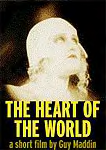
The Silence of the Wolves
Maddin's "silent" films, like the brilliant, six-minute Heart of the World, the hour-long Cowards Bend the Knee (2003) or the poignant (and hilarious) musical The Saddest Music in the World (2003) -- all my top picks -- are fast, faster than the silent films so lovingly or scathingly parodied. Heart is fastest of all, since, to the stirring pulse of Georgi Sviridov's Time, Forward, it condenses all of Russian silent cinema (and German Expressionist cinema) into a few breathtaking minutes, thus deserving its reputation as the best of recent "experimental" films.
Here I have to describe the signature Maddin "look" of flickering imagery, iris shots, and fake disintegration of film stock. Not a fan of the silent period of movies, I confess that seeing one of Maddin's pseudo-silents made me want to look at them again -- but when you do look at them, at the correct speed or even the speeded-up usual versions, they are SO SLOW. I rented an early Hitchcock silent called Downhill, which was sans the music track. Without a rolling piano or string quartet to guide one through the emotions, it was nearly impossible to "read." Maddin makes "silent" movies the way you would want them to be: with sound and sometimes even the spoken word, along with the impression you yourself are being fast-forwarded on your VCR or DVD. The convoluted plots may crawl along, but the images (and the over-the-top emotions) are on speed.
But silence isn't always golden.
In Careful (1992), which after two viewings has become another favorite, Maddin presents an imaginary mountain community where silence -- as in early motion pictures -- is the rule. Animals have their vocal cords cut, and even geese passing above might trigger a deadly avalanche. Cavorting is saved for special valleys, where the echoes cancel out the sounds they are echoing.

Cowards Bend the Knee, 2003 (Actors as wax replicas of Maroon hockey team)
Acting Is a Popular Disease
All of Maddin's movies, with the exception of Twilight,imitate silent movies, even if there's actual dialogue. Perhaps it would be better to say that he often points to early sound movies, or what they would have been like if silent-movie montage had been maintained. If there is dialogue, it is usually stilted and either postproduction or, if synchronized, sounds as if it's dubbed. The actors deliver their lines as if they are, as one says, phoning them in. An exception, along with the ever-game Rossellini as a Canadian beer baroness, is the ever-charming Shelley Duvall. Her role as the host of television's once-popular Faerie Tale Theater helps create the atmosphere of the lush and lugubrious Twilight.
Twilight, however, is not a full-color fable for the kiddies. In spite of the saving grace of John McCulloch's journey-music, it is even darker and certainly more perverse than any Cocteau tale. After the promising lines, "Aren't you tired of thinking like a prisoner? How about thinking like a criminal?" we have to wade through many dead scenes and arch poses until, more than three-quarters through, we get to see Duvall go totally bonkers and hammer a spike into the head of a crusty, impotent ostrich farmer. This is the high point.
After Twilight of the Ice Nymphs (not typical, but seemingly in perpetual replay on the Sundance TV channel), Maddin tried to make a big operetta film called The Dykemaster's Daughter. He couldn't raise the mere million he needed. I don't know why the Canadian government couldn't come up with the money; after all, it was to star British horror actor Christopher Lee and Leni Riefenstahl (notorious director of Triumph of the Will) in her acting comeback. She had started as an actress in silent, very-German alpine flicks. Dykemaster's probably fits into the select category of The Wildest, Most Unlikely Movies Never Made.
In fairness, most of the "acting" is just what Maddin wants. Like Hitchcock, he tells his actors as little as possible, so, he says, so they won't take the movie away from him. He also reveals that he coached the actor who had to pretend to eat his father's corpse -- in his first movie, The Dead Father (1986) -- to "eat yogurt by the light of a refrigerator as if he really disliked yogurt.")
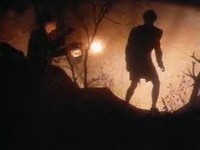
Careful, 1990
More Movies, Music, Writing and Camp
I'll pass by, this time around, Archangel -- about Canada's largely unknown intervention against the Bolshevek revolution -- and Tales from the Gimli Hospital, 1988, (which approaches the forbidden subject of a devastating epidemic in the Canadian, largely Icelandic community of Gimli, north of Winnipeg.) Both have their charms.
The most recent movies (and therefore not yet available on DVD), Cowards and The Saddest Music, like all of Maddin's works, are long on plot and deliriously short on sense. So that I do not ruin your eventual delight or disgust, suffice it to say that Cowards, Maddin's most autobiographical effort, was initially meant as a gallery installation in the form of 12 peep-shows. It's about destiny, hockey, beauty parlors, incest, and the Hands of Orlac; The Saddest Music is only outwardly about a maniacal female owner of a Canadian beer company. She (played by Rossellini) has the brilliant idea that now that Prohibition has been abolished, she will encourage the drinking of beer by mounting an international radio contest to find the saddest music in the world. It is, by the way, hilarious that mariachi music from Mexico is one of the entries.
In my view, if movies be music, than Maddin wins any such contest for sadness. Beneath the parody and the mayhem, there's a lonely child trying to get out of a Canadian straight-jacket. What was it like to grow up in Winnipeg in an Icelandic family, father working for a famous hockey team, auntburning hair in her beauty shop downstairs? Did little Guy, as he claims, actually crawl up the beauty parlor hair-shoot to spy on the ladies? Was there really a blue hand under one of the sinks?
Maddin's writings (From the Atelier Tovar: Selected Writings, Coach House Books, 2003), are as pleasingly overwritten as his movies are overwrought. The journal entries, screen treatments, and reviews will let you in on lazy-boy Maddin's secrets -- but no more than Cowards, whose main character is called Guy Maddin. Most will see an element of camp in Maddin's films. Yet in spite of a few male shower scenes and the hilarious short Sissy Boy Slap Party (1990), Maddin appears to be straight, has a grown daughter he dotes on, but, divorced, seems unlucky in love. So much for the still socially prevalent assumptions about ironclad links between sexuality and temperament. (And, judging by the way he dresses for the documentary Waiting for Twilight, he is not even a metrosexual.) But, as all of his movies prove, even a former stick boy for the Winnipeg Maroons hockey team can dish out emotions exaggerated beyond all cause. If this be camp, then it is camp about camp, meta-camp.
Cocteau once promised that making a film would be like writing. In Maddin's best efforts, 10 percent usually is writing, in the form of intertitles. Then too, the images have a certain written-ness about them. They stick in your mind like images from bad poems, too vivid for their own good. It is their vividness that is their meaning, not their referents.
These oddly moving movies are more Jacobean than Restoration. In Careful, the blond and goofy youth who kisses his sleeping mother's exposed breast, burns his mouth with a live coal and cuts off his fingers inremorse-- before jumping off a cliff. Of course, like the whole movie, the kiss may have been a dream. The remaining brother, also incest-prone, has his brother's fingers sewn back on so that their truly loopy and self-centered mother won't know the fall was suicide. Tragedy is communicated by farce, or vice-versa.
Update: Films of Guy Maddin @ Berkeley Museum of Art to Oct. 31.
AJ Ads
AJ Blogs
AJBlogCentral | rssculture
Terry Teachout on the arts in New York City
Andrew Taylor on the business of arts & culture
rock culture approximately
Laura Collins-Hughes on arts, culture and coverage
Richard Kessler on arts education
Douglas McLennan's blog
Dalouge Smith advocates for the Arts
Art from the American Outback
For immediate release: the arts are marketable
No genre is the new genre
David Jays on theatre and dance
Paul Levy measures the Angles
Judith H. Dobrzynski on Culture
John Rockwell on the arts
Jan Herman - arts, media & culture with 'tude
dance
Apollinaire Scherr talks about dance
Tobi Tobias on dance et al...
jazz
Howard Mandel's freelance Urban Improvisation
Focus on New Orleans. Jazz and Other Sounds
Doug Ramsey on Jazz and other matters...
media
Jeff Weinstein's Cultural Mixology
Martha Bayles on Film...
classical music
Fresh ideas on building arts communities
Greg Sandow performs a book-in-progress
Exploring Orchestras w/ Henry Fogel
Harvey Sachs on music, and various digressions
Bruce Brubaker on all things Piano
Kyle Gann on music after the fact
Greg Sandow on the future of Classical Music
Norman Lebrecht on Shifting Sound Worlds
publishing
Jerome Weeks on Books
Scott McLemee on books, ideas & trash-culture ephemera
theatre
Wendy Rosenfield: covering drama, onstage and off
Chloe Veltman on how culture will save the world
visual
Public Art, Public Space
Regina Hackett takes her Art To Go
John Perreault's art diary
Lee Rosenbaum's Cultural Commentary
Tyler Green's modern & contemporary art blog
